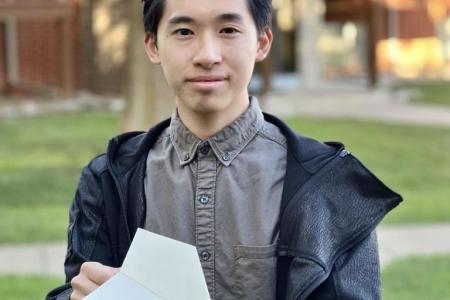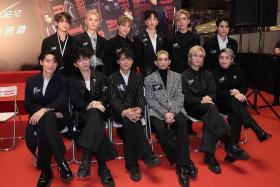Malaysian-born aviation engineer's paper plane breaks Guinness World Record
KUALA LUMPUR (THE STAR/ASIA NEWS NETWORK) - Most people would remember folding paper aeroplanes for fun when they were children, but it has always been Mr Julian Chee's childhood dream to design such planes and break records.
And recently, he and his South Korean teammates did just that.
Currently based in Kansas, in the United States, Mr Chee, 24, has earned a Guinness World Record in the "Farthest flight by a paper aircraft" category.
His paper plane flew 77.134m, beating the previous record of 69.14m set by Americans John Collins and Joe Ayoob in 2012.
"It's no moonshot but I represent Malaysia to the best of my ability. It's definitely not going to be my last," Mr Chee said in an e-mail interview recently.
Asked if he had ever expected to break the record, he said: "Yes, I did. Back in 2019, I tested my design in an airplane hangar and I hit approximately 90 per cent of the 2012 record distance on the first day alone. So I knew it was within reach with a bit more refinement."
Mr Chee, a design engineer with European multinational aerospace firm Airbus, teamed up with his South Korean buddies Kim Kyu-tae and Shin Moo-joon to tackle the challenge. The trio achieved their distance in Daegu, Gyeongsangbuk-do in South Korea on April 16.
They each had a specific area to focus on: Mr Shin - a paper aircraft veteran - folded the plane, Mr Kim was the thrower, while Mr Chee was the designer.
"I have known Shin for nearly a decade now, and we've constantly been discussing, via e-mail and social media, new ways to fly higher, further and longer. So in 2019, I did some tests at my university's indoor baseball park and an old Boeing hangar in Wichita, Kansas," Mr Chee said.
"Unfortunately, I didn't continue the project as school and work kept me busy. Shin was the only person who knew my design and he introduced me to Kim with the plan to break the record. The community in (South) Korea also started noticing my design, so we wanted to quickly get it in the record books, and we did," said Mr Chee, who graduated from the Wichita State University in aerospace engineering last year.
The former SMK Taman SEA (Petaling Jaya) student took months of research to conceptualise the design. He explained that there are a few factors influencing the performance of any aircraft but in the end, it boils down to the balancing act between the mass and how big the wing area is.
"The heavier the paper, the more inertia it possesses to keep it going, and the better the structure. The smaller the wings, the faster it flies too," he explained.
"For this application, the wings must be sized so they can still glide at a particular speed, or they'll just hit the ground like a dart."
Mr Chee said throwing a paper airplane seems easy, but thrusting it at high speeds with minimal distortions, consistency and endurance is much more complex.
"Unexpectedly, the challenge is getting it to fly straight at various speeds because the paper is a soft material. Often, throwing itself would distort and damage the wings, causing the plane to roll or turn rapidly," he said.
"Compared to the 2012 record glider, my design is smaller, with more layers compacted into the wing, making it stiffer and less prone to distortion. As a result, our winning plane started gliding from a much higher altitude rather than a very aggressive swoop down to pick up more speed."
Mr Chee said paper planes are a kid's version of engineering and art.
"Since it's a lot faster and cheaper to make something from old mail (or an exam paper that I never want to see again!), there's a lot of trial and error," he said.
"Every throw is an experiment to learn from, and that's incredibly important for any kid trying to figure out how the world works. It's also a great outlet to let the mind wonder," he added.
"Whether it's a flapping plane, one that resembles a bird, replicas of existing airplanes, or just a high-performance glider, it's endless. That's the best part. It's simple in concept, but complex in possibilities."
Aside from creating origami aircraft, Mr Chee also enjoys music and playing the yoyo.
Next, the engineer wants to design, build and launch a small but efficient rocket into space.
"It will take a few years as I'm in the midst of studying and writing the analysis code and learning how to manufacture rocket propellant," he said.
Get The New Paper on your phone with the free TNP app. Download from the Apple App Store or Google Play Store now


